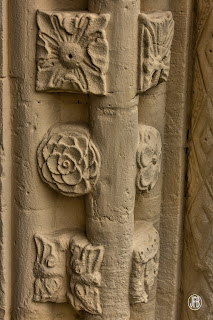Le choix d'un deuxième article consacré uniquement à la dernière voussure du portail ouest apparaîtra sans doute disproportionné mais j'ai seulement voulu dissocier la partie géométrique des formes qui prédominent largement de la représentation figurative, qui bien que plus discrète est d'un grand intérêt.
Cette fois c'est à Lucien Musset que l'on doit quelques lignes descriptives seulement.
Cette archivolte qui encadre l'ensemble du décor de beakheads, prend la forme d'un ruban perlé que crachent des tètes de monstres .
Le ruban semble s'enrouler sur lui-même pour former des mandorles en 8 dans lesquelles sont sculptées des figures diverses ou les signes du zodiaque .
Parfois ce sont des poissons ou les symboles des évangélistes ou de simples fantaisies qui ne sont pas sans rappeler l'église de Barefrestone dans le Kent.
La décoration de ce portail reste cependant assez originale et contraste avec le portail sud plus fortement marqué par la tradition anglo-saxonne ou nordique. En effet ici, à l'exception de têtes de lion d'où sort la guirlande décorative, tous les thèmes appartiennent au registre plus "orthodoxe" de la liturgie romaine.
Malgré la véritable unité de style de l'ensemble architecture et sculptures de cette église on peut imaginer la présence de deux sculpteurs, à moins que le sculpteur de la façade, satisfait de la beauté de son travail ait retrouvé plus de liberté au portail sud, mais tout cela n'est qu'hypothèses.
Google translate.
The choice of a second article devoted only to the last arch of the west portal will undoubtedly appear disproportionate but I only wanted to dissociate the geometric part of the forms which largely predominate from the figurative representation, which although more discreet is of great importance. interest.This time it is to Lucien Musset that we owe only a few descriptive lines.This archivolt which frames the entire beakhead decor, takes the form of a beaded ribbon spewed out by monster heads.The ribbon seems to roll up on itself to form 8-shaped mandorles in which various figures or signs of the zodiac are carved.Sometimes they are fish or the symbols of the evangelists or simple fantasies which are not unlike the church of Barefrestone in Kent.The decoration of this portal however remains quite original and contrasts with the southern portal more strongly marked by the Anglo-Saxon or Nordic tradition. Indeed here, with the exception of lion heads from which the decorative garland comes out, all the themes belong to the more "orthodox" register of the Roman liturgy.Despite the true unity of style of the architecture and sculptures of this church, one can imagine the presence of two sculptors, unless the sculptor of the facade, satisfied with the beauty of his work, has found more freedom at the south portal, but these are all hypotheses.

















































